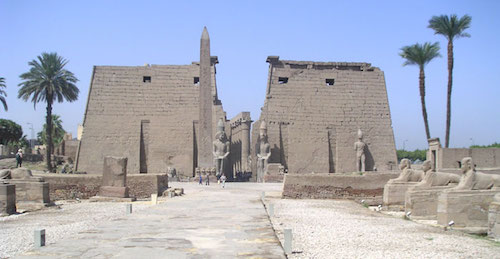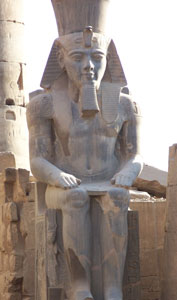The temple of Luxor is situated on the east bank of the River Nile in the town of Luxor (Thebes). The temple was known as “ipet resyt” (“the southern harem”) and it was founded during the New Kingdom, around 1400 BC.
The temple is dedicated to Amun, Mut, and Khonsu and was the focus of one of the most important religious festivals in ancient Egypt – the annual Opet Festival. During this festival the cult statues of Amun, Mut and Khonsu would travel from Karnak to Luxor. As a result, the temple is not aligned to the river (as is more usual) but to the temple complex at Karnak.
It is also proposed by some that the temple of Luxor was in fact dedicated to the royal ka, which was symbolically joined to the living king during the Opet festival. Thus, the Luxor Temple was a shrine of the king’s cult and not just to the Theban god Amun and his family.

Layout

- Avenue of sphinx
- First pylon
- Roman camp
- Mosque
- Court of Ramessess II
- Court of Amenhotep III
- Chapel of Mut
- Chapel of Khonsu
- Chapel of Amun
- Birth chamber
Access to the site in modern times is by a gate thought to have been constructed during the Roman period. In ancient times, the temple was approached by a long avenue, which connected Karnak and Luxor temples, leading to the first pylon. Nectanebo I lined this processional road with human headed sphinx but this was a rather late addition to the site (dynasty 30) and it is thought that he merely built over an existing processional way.
The original road may have been constructed by Hatshepsut, and Amenhotep III later added to the avenue by lining it with ram-headed sphinx. The entire site is surrounded by a large mudbrick enclosure wall built by Nectanebo I.
The entrance to the temple is known as the first pylon. It was built by Ramesses II and was decorated with scenes of his military expeditions, in particular, his triumph at the battle of Kadesh. The pylon towers originally supported four huge cedar flag masts from which banners would have fluttered in the breeze.

Later pharaohs (most notably the Nubian kings of dynasty twenty-five) added scenes recording their own military triumphs to the first pylon. This entrance was flanked by six massive statues of Ramesses, two seated and four standing. These statutes have crumbled with time, but fortunately the two seated statues are still relatively intact.

There is also a 25 metre pink granite obelisk, also built by Ramesses, just inside the gateway. It is one of a pair – the other now stands in the Place de la Concorde in Paris. The four sacred baboons who greet the morning sun are carved on the pedestal and the names and epitaphs of Ramesses appear on each side of the obelisk.

Beyond the first pylon Ramesses II built a peristyle courtyard (replacing an earlier court thought to have been constructed by Amenhotep III) which was set at an angle to the rest of the temple in order to preserve three pre-existing barque shrines constructed by Hatshepsut (with later additions) which stand in the northwest corner. The court is composed of a colonnade including a number of colossal statues of Amenhotep III which were usurped by Ramesses II. The Abu’l Hagag mosque perches precariously at the top of the columns of this courtyard. As a result one of the doorways, on the eastern side, hovers uselessly above the ground.
The peristyle courtyard leads to the processional colonnade built by Amenhotep III with additional decorations added by Tutankhamun, Horemheb, and Seti I. By the entrance to the colonnade there are two statues representing Tutankhamun, but on each his name has been replaced by that of Ramesses II. It is lined with fourteen huge papyrus topped columns and the walls are decorated with scenes depicting the stages of the Opet Festival. Other decorations celebrate the reinstatement of Amun and the other traditional gods following the Atenist heresy. They are ascribed to Tutankhamun, but his name has been erased and replaced by that of Horemheb.
Copyright J Hill 2010